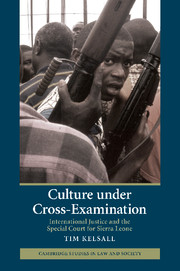Book contents
- Frontmatter
- Contents
- List of illustrations
- Preface
- 1 White man's justice? Sierra Leone and the expanding project of international law
- 2 The story of the CDF trial
- 3 An unconventional army: chains of command in a patrimonial society
- 4 Facts, metaphysics and mysticism: magical powers and the law
- 5 We cannot accept any cultural consideration: the child soldiers charge
- 6 ‘He's not very forthright’: finding the facts in a culture of secrecy
- 7 Cultural issues in the RUF, AFRC and Charles Taylor trials
- 8 Conclusion: from legal imperialism to dialogics
- References
- Index
5 - We cannot accept any cultural consideration: the child soldiers charge
Published online by Cambridge University Press: 18 January 2010
- Frontmatter
- Contents
- List of illustrations
- Preface
- 1 White man's justice? Sierra Leone and the expanding project of international law
- 2 The story of the CDF trial
- 3 An unconventional army: chains of command in a patrimonial society
- 4 Facts, metaphysics and mysticism: magical powers and the law
- 5 We cannot accept any cultural consideration: the child soldiers charge
- 6 ‘He's not very forthright’: finding the facts in a culture of secrecy
- 7 Cultural issues in the RUF, AFRC and Charles Taylor trials
- 8 Conclusion: from legal imperialism to dialogics
- References
- Index
Summary
The Special Court for Sierra Leone made jurisprudential history when it became the first international court ever to try defendants for the crime of enlisting soldiers under the age of fifteen. The figure of the child soldier, sometimes as young as seven or eight, high on drugs, wielding an AK-47, and committing atrocities such as cutting the limbs off civilians or slitting the bellies of pregnant women, loomed large in the reportage and iconography of Sierra Leone's civil war. Under its Statute, the Court was empowered to prosecute some of these soldiers, specifically those over the age of fifteen at the time the offences occurred. Soon after arriving in Freetown, however, Prosecutor David Crane made it clear that he would focus not on prosecuting child soldiers, but on prosecuting those who bore the greatest responsibility for recruiting them instead (Sriram 2006, 485). So it was that Sam Hinga Norman and his co-accused found themselves charged with initiating or enlisting children, an allegation that raised controversial legal and cultural issues, each of which this chapter will discuss in turn.
PRE-TRIAL PROCEEDINGS
The legal controversy, aired primarily in the pre-trial proceedings, was centred on the question of whether or not enlisting child soldiers was a crime under international law at the time the alleged offences were committed. To give a brief procedural history, the defence filed a motion on 26 June 2003 challenging the Court's jurisdiction over the crime of child recruitment.
- Type
- Chapter
- Information
- Culture under Cross-ExaminationInternational Justice and the Special Court for Sierra Leone, pp. 146 - 170Publisher: Cambridge University PressPrint publication year: 2009
- 1
- Cited by

